
The Royal Australian Air Force (RAAF) is the principal aerial warfare force of Australia, a part of the Australian Defence Force (ADF) along with the Royal Australian Navy and the Australian Army. Constitutionally the Governor-General of Australia is the de jure Commander-in-Chief of the Australian Defence Force. The Royal Australian Air Force is commanded by the Chief of Air Force (CAF), who is subordinate to the Chief of the Defence Force (CDF). The CAF is also directly responsible to the Minister for Defence, with the Department of Defence administering the ADF and the Air Force.

The Roulettes are the Royal Australian Air Force's formation aerobatic display team. They provide about 150 flying displays a year, in Australia and in friendly countries around the Southeast Asian region. The Roulettes form part of the RAAF Central Flying School (CFS) at RAAF Base East Sale, Victoria.
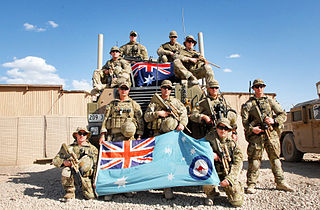
Airfield Defence Guards (ADG) are a mustering of the Royal Australian Air Force (RAAF) that are dedicated to the security and ground defence of airbases and other military aviation assets. Other duties include training other RAAF personnel, in skills such as the handling of small arms and infantry tactics. They do not, however, operate anti-aircraft artillery or missiles.
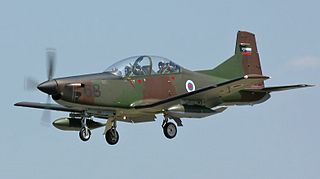
The Pilatus PC-9 is a single-engine, low-wing tandem-seat turboprop training aircraft manufactured by Pilatus Aircraft of Switzerland. Designed as a more powerful evolution of the Pilatus PC-7, the PC-9's first flight was made in May 1984 after which certification was achieved in September 1985. After this, the first production orders for the type were received from the Royal Saudi Air Force, with deliveries commencing in 1985. Since then, more than 250 airframes have been produced across five different variants, and the type is employed by a number of military and civilian operators around the world, including the Swiss Air Force, Croatian Air Force, Royal Thai Air Force and the Irish Air Corps

The Pilatus PC-21 is a turboprop-powered advanced trainer with a stepped tandem cockpit. It is manufactured by Pilatus Aircraft of Switzerland.

The Pacific Aerospace Corporation CT/4 Airtrainer series is an all-metal-construction, single-engine, two-place with side-by-side seating, fully aerobatic, piston-engined, basic training aircraft manufactured in Hamilton, New Zealand.

RAAF Base East Sale is a Royal Australian Air Force (RAAF) military air base and training school, located in Sale, Victoria, Australia. The base is one of the main training establishments of the RAAF, including where Australian Air Force Cadets from 4 Wing (Victoria) have their biannual General Service Training as well as being home to No. 409 Squadron Australian Air Force Cadets. It is home to The Roulettes aerobatic team. It is also now the home of the RAAF's Officers' Training School (OTS) following its relocation from RAAF Base Point Cook. East Sale was upgraded to house the new OTS, which had its first intake of students in January 2008. The base houses approximately 700 air force personnel.

No. 4 Squadron is a Royal Australian Air Force squadron composed of the air force special forces Combat Controllers, aircrew who operate the Pilatus PC-21 aircraft and instructors for the Australian Defence Force Joint Terminal Attack Controller (JTAC) course.

RAAF Base Wagga is a Royal Australian Air Force (RAAF) military air base located 11 kilometres (6.8 mi) south-east of Wagga Wagga, in the suburb of Forest Hill, New South Wales, Australia.

No. 2 Flying Training School is the main flying training school of the Royal Australian Air Force (RAAF). Formed under its present name in 1969, it is located at RAAF Base Pearce, Western Australia. The unit operates a fleet of Pilatus PC-21 turboprop trainers. No. 2 FTS traces its origins to the post-war re-establishment of the Air Force's original cadet training unit, No. 1 Flying Training School, at RAAF Point Cook, Victoria, in 1947. Following reorganisation of aircrew training in 1951–52, No. 1 FTS was renamed No. 1 Applied Flying Training School, and began specialising in advanced flight instruction on CAC Wirraways. It relocated to RAAF Base Pearce in 1958, where it converted to De Havilland Vampire jet trainers. In January 1969, the school was reformed as No. 2 FTS, having the previous year begun replacing the Vampires with Macchi MB-326Hs. The Macchis were themselves replaced by the PC-9 beginning in 1989.

The Royal Australian Air Force's Aircraft Research and Development Unit (ARDU) plans, conducts and analyses the results of ground and flight testing of existing and new Air Force aircraft. ARDU consists of three test and evaluation flights (TEFs) located at RAAF Bases Edinburgh, Amberley and Williamtown, staffed by qualified test pilots, flight test engineers and flight test system specialists. ARDU also conducted flight testing for the Australian Army until 2016, with Army personnel working within the unit.

The CAC CA-25 Winjeel is an Australian-designed and manufactured three-seat training aircraft. Entering service with the Royal Australian Air Force (RAAF) in 1955 as a basic to advanced trainer, it served in this role until 1975. Later, it was used in the Forward Air Control (FAC) role for target marking until 1994, after which it was retired from RAAF service.

Air Force Training Group is the Royal Australian Air Force (RAAF) group responsible for training personnel. It is headquartered at RAAF Williams, Victoria. The group was established as Training Command in 1953. It formed part of Support Command between from 1959 to 1990, when it was re-established as Training Command. In July 2006, Training Command was re-formed as Air Force Training Group under Air Command. Air Force Training Group consists of a headquarters and two Academies: Air Academy and Ground Academy.

The Royal Australian Air Force's Air Combat Group (ACG) is the group which administers the RAAF's fighter and bomber aircraft. ACG was formed on 7 February 2002 by merging the RAAF's Tactical Fighter Group and Strike Reconnaissance Group in an attempt to improve the speed with which the RAAF can deploy its combat aircraft.

Central Flying School (CFS) is a Royal Australian Air Force (RAAF) training unit, located at RAAF Base East Sale, Victoria. It operates the Pilatus PC-21 turboprop trainer. The school is responsible for training flight instructors, setting flying standards, and auditing flying practices. It is also home to the "Roulettes" aerobatic team. CFS was the first military aviation unit to be formed in Australia, in 1913, when its role was to provide basic flying training. Its current form dates from World War II, when it was re-established to train flying instructors for the Empire Air Training Scheme (EATS).
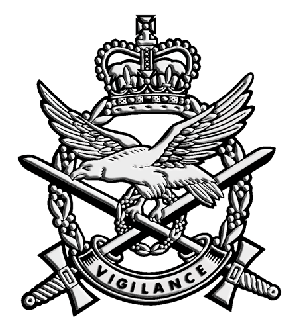
The Australian Army Aviation (AAAvn) is an administrative corps of the Australian Army. It was formed on 1 July 1968. The motto of the Australian Army Aviation corps is Vigilance.
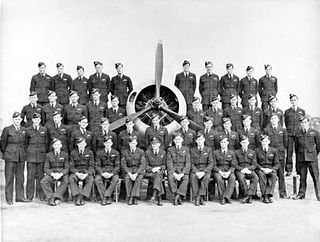
No. 5 Service Flying Training School was a Royal Australian Air Force (RAAF) flight training unit that operated during World War II. It was one of eight Service Flying Training Schools established by the RAAF to provide intermediate and advanced flying instruction to new pilots as part of Australia's contribution to the Empire Air Training Scheme. No. 5 SFTS was formed at RAAF Station Uranquinty, New South Wales, in October 1941, and disbanded in February 1946. Its staff and equipment were employed to re-establish No. 1 Flying Training School, which transferred to RAAF Station Point Cook, Victoria, the following year. Care and Maintenance Unit Uranquinty was also formed from No. 5 SFTS's facilities, to look after surplus aircraft at the base prior to their disposal, and disbanded in December 1948.
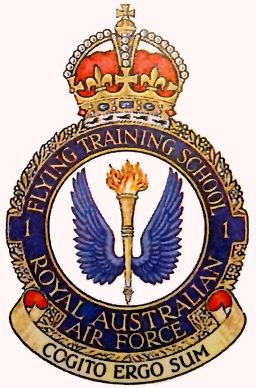
No. 1 Flying Training School is a school of the Royal Australian Air Force (RAAF). It is one of the Air Force's original units, dating back to the service's formation in 1921, when it was established at RAAF Point Cook, Victoria. By the early 1930s, the school comprised training, fighter, and seaplane components. It was re-formed several times in the ensuing years, initially as No. 1 Service Flying Training School in 1940, under the wartime Empire Air Training Scheme. After graduating nearly 3,000 pilots, No. 1 SFTS was disbanded in late 1944, when there was no further requirement to train Australian aircrew for service in Europe.

No. 1 Basic Flying Training School was a flying training school of the Royal Australian Air Force (RAAF). Along with No. 1 Initial Flying Training School, it was formed in response to increased demand for aircrew during the Korean War and Malayan Emergency. No. 1 BFTS was established in December 1951 at RAAF Base Uranquinty, New South Wales, where it operated de Havilland Tiger Moths and CAC Wirraways. The school absorbed the activities of No. 1 IFTS in January 1955, as aircrew training requirements had eased following the end of the Korean War. No. 1 BFTS moved to RAAF Base Point Cook, Victoria, in May 1958, by which time it was exclusively flying CAC Winjeels. Its training program expanded in the mid-1960s owing to Australia's commitments in the Vietnam War. No. 1 BFTS was re-formed as No. 1 Flying Training School at Point Cook in January 1969.

No. 1 Initial Flying Training School was a flying training school of the Royal Australian Air Force (RAAF). It was formed in 1951 as No. 1 Initial Training School, in response to increased demand for aircrew during the Korean War and Malayan Emergency. Headquartered at RAAF Station Archerfield, Queensland, and operating de Havilland Tiger Moths, the unit was renamed No. 1 Initial Flying Training School in 1952. Ground staff from the school won the Hewitt Trophy for small arms proficiency in 1953. Aircrew training requirements eased following the end of the Korean War, and No. IFTS merged with No. 1 Basic Flying Training School at RAAF Base Uranquinty, New South Wales, in 1955.




















